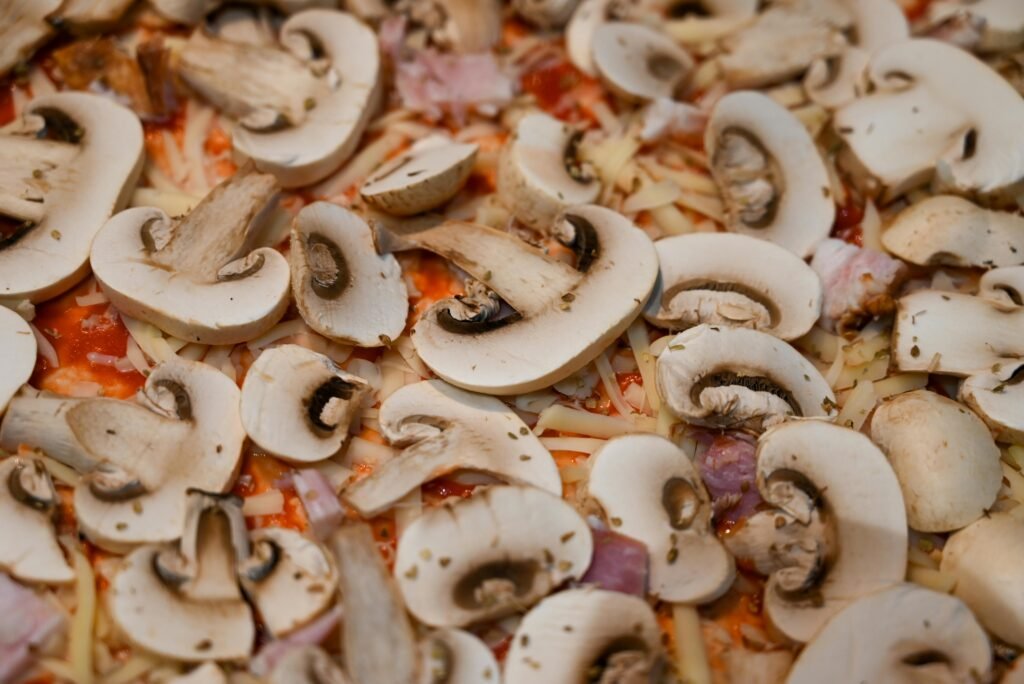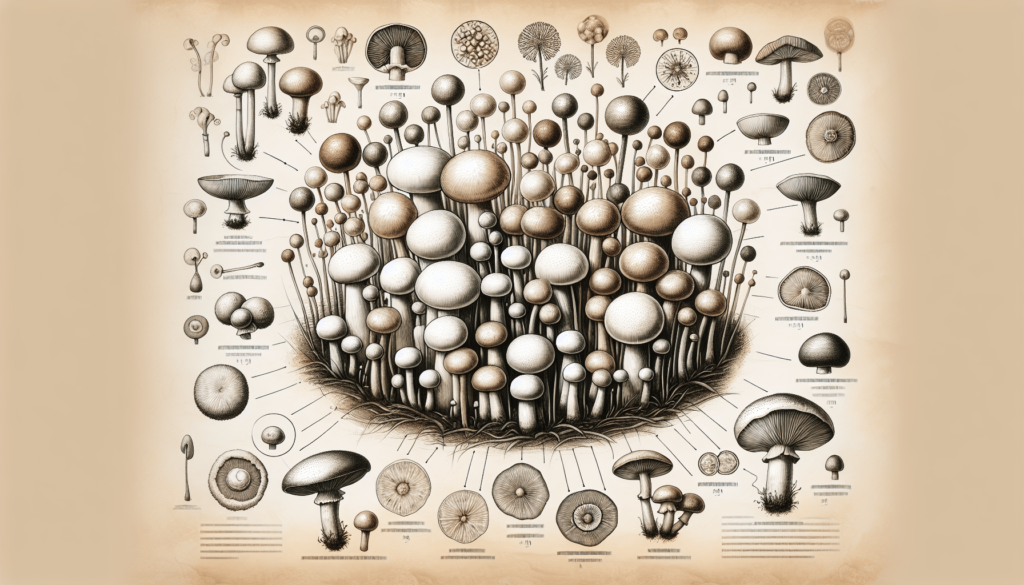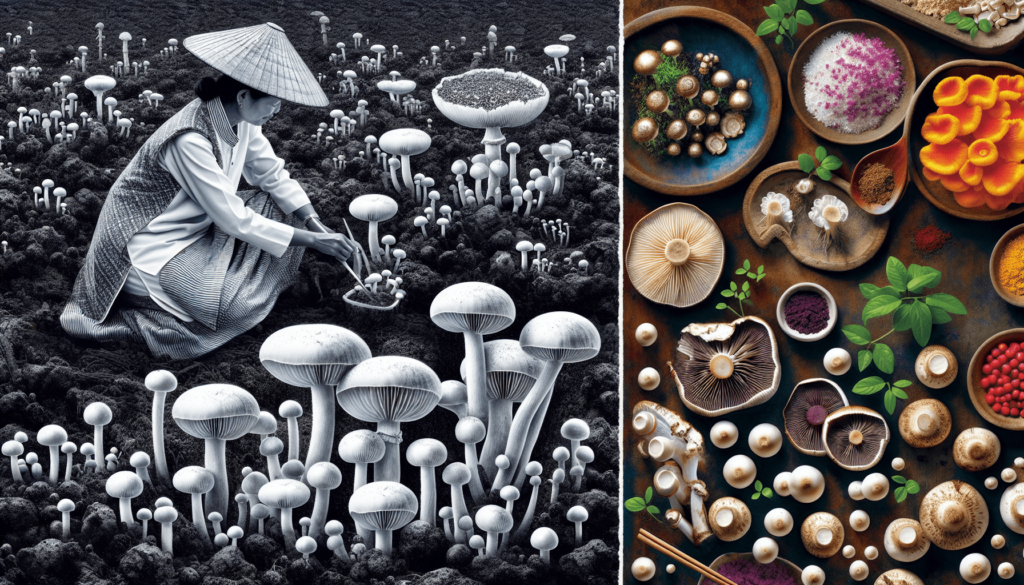Are you a mushroom lover looking to broaden your culinary horizons? Look no further than the versatile Agaricus bisporus! This fascinating article will take you on a journey of discovery as you learn about the cultivation process and explore the myriad of culinary uses for this extraordinary mushroom. From its humble beginnings as a tiny spore to its appearance on your dinner plate, you will be captivated by the secrets and surprises hidden within the world of Agaricus bisporus. So, grab your apron and get ready to elevate your cooking skills with this culinary gem!

1. Introduction to Agaricus bisporus
1.1 Overview
Agaricus bisporus, commonly known as the white button mushroom, is one of the most widely cultivated and consumed mushroom species in the world. It belongs to the family Agaricaceae and is characterized by its pale color, umbrella-shaped cap, and delicate texture. This mushroom is highly versatile and can be used in a variety of culinary preparations due to its mild flavor and ability to absorb other flavors during cooking.
1.2 Taxonomy and Classification
Agaricus bisporus falls under the order Agaricales and is classified in the Basidiomycota division. It is a saprophytic fungus, meaning it obtains nutrients by decomposing organic matter, particularly plant material. Within the genus Agaricus, A. bisporus is further classified into different varieties based on their color and maturity stage, including white button mushrooms, crimini mushrooms, and portobello mushrooms.
1.3 History and Cultivation
The cultivation of Agaricus bisporus can be traced back thousands of years, with evidence of its consumption found in ancient Egyptian and Roman cultures. However, it wasn’t until the late 17th century that A. bisporus was actively cultivated for commercial purposes. The technique of growing white button mushrooms was first developed in France and England, and it quickly spread to other parts of Europe and eventually to North America.
2. Cultivation of Agaricus bisporus
2.1 Growing Conditions
Agaricus bisporus thrives in specific environmental conditions. It prefers temperatures ranging from 12-24°C (54-75°F) and relative humidity levels of around 70-80%. The mushrooms also require proper air circulation to prevent the build-up of carbon dioxide, which can affect their growth. Additionally, adequate light exposure, preferably diffused light, is essential for the development of mushroom caps with desirable shape, texture, and color.
2.2 Growing Medium
The growing medium for Agaricus bisporus is typically composed of organic materials such as composted straw, horse manure, and gypsum. These materials provide the necessary nutrients for the mushrooms to grow and develop. The composting process involves carefully monitoring and adjusting factors such as temperature, moisture, and oxygen levels to create an ideal environment for the growth of beneficial microorganisms that help break down the organic matter.
2.3 Spawn Preparation
Spawn, which serves as the “seed” for mushroom cultivation, is prepared by introducing a culture of Agaricus bisporus mycelium into a substrate such as sterilized grains or sawdust. The mycelium, a network of fine threads, colonizes the substrate, and when it reaches maturity, it is ready for use in the cultivation process. Spawn can be produced commercially or by hobbyists using specialized equipment and sterile techniques.
2.4 Composting
Once the growing medium has been prepared, it undergoes a composting process to create the optimal conditions for mushroom growth. Composting involves blending the organic materials and creating suitable temperature and moisture conditions for the growth and activity of microorganisms. This process helps break down complex compounds into more accessible forms, converting them into nutrients that can be readily absorbed by the mushrooms.
2.5 Spawning and Casing
After composting, the spawn is mixed thoroughly into the compost to inoculate it with Agaricus bisporus mycelium. The compost-spawn mixture is then placed into trays or beds and topped with a layer of casing material, such as peat moss or a mixture of peat and vermiculite. The casing layer provides a favorable microenvironment for the mycelium to develop and induces the formation of fruiting bodies.
2.6 Incubation and Harvesting
During the incubation period, the trays or beds containing the compost-spawn-casing mixture are kept in a controlled environment with optimal temperature and humidity. This allows the mycelium to grow and spread throughout the substrate, eventually forming a network of fine threads. Once the mycelium has fully colonized the substrate, mushrooms begin to emerge from the casing layer. Harvesting is typically done when the mushrooms reach the desired size and before the cap opens up.
3. Varieties of Agaricus bisporus
3.1 White Button Mushrooms
White button mushrooms, the most common variety of Agaricus bisporus, are harvested when they are young and have a compact white cap. They have a mild and slightly earthy flavor, making them suitable for various culinary applications.
3.2 Crimini Mushrooms
Crimini mushrooms, also known as baby bella mushrooms or brown button mushrooms, are harvested when they are slightly more mature than white button mushrooms. They have a dark brown color and a richer flavor compared to their white counterparts, with some describing it as nutty or earthy.
3.3 Portobello Mushrooms
Portobello mushrooms are the fully mature stage of Agaricus bisporus and have a large size and distinctive cap structure. They are brown in color and have a more intense flavor compared to white button and crimini mushrooms. Portobello mushrooms are often grilled or roasted, and their meaty texture makes them a popular choice as a meat substitute in vegetarian dishes.
3.4 Other Varieties
In addition to the commonly known varieties, there are various other cultivated and wild varieties of Agaricus bisporus that differ in terms of color, size, and flavor. Some examples include almond mushrooms, snow mushrooms, and horse mushroom varieties. These lesser-known varieties offer unique characteristics and flavors that can add diversity to culinary preparations.
4. Nutritional and Health Benefits of Agaricus bisporus
4.1 Macronutrient Content
Agaricus bisporus is low in calories and fat while being a good source of dietary fiber. It also contains essential macronutrients such as carbohydrates and protein, making it a nutritious food option.
4.2 Micronutrient Content
White button and crimini mushrooms are particularly rich in vitamins and minerals. They are an excellent source of B vitamins, including riboflavin (B2), niacin (B3), and pantothenic acid (B5). These vitamins play crucial roles in energy metabolism and maintaining healthy skin and nerves. Mushrooms also contain minerals like potassium, phosphorus, and selenium, which are vital for various bodily functions.
4.3 Role in a Healthy Diet
Incorporating Agaricus bisporus into a balanced diet can provide important nutrients, contribute to satiety, and support overall health and well-being. These mushrooms are low in sodium and cholesterol and can be included in diets focusing on weight management, heart health, and overall nutrient intake.
4.4 Potential Health Benefits
Research has shown that Agaricus bisporus contains bioactive compounds with potential health benefits. These compounds, including polysaccharides and phenolic compounds, exhibit antioxidant, anti-inflammatory, and immune-enhancing properties. Studies have suggested that consuming mushrooms like Agaricus bisporus may have anti-cancer, anti-diabetic, and anti-obesity effects, although further research is needed to establish specific mechanisms and therapeutic applications.

5. Culinary Uses of Agaricus bisporus
5.1 Raw vs. Cooked
Agaricus bisporus can be consumed both raw and cooked, but cooking helps bring out its flavors and enhance texture. While raw mushrooms have a mild and slightly crunchy texture, cooking them can intensify their flavor, soften their texture, and impart a pleasant earthy aroma.
5.2 Common Culinary Preparations
White button, crimini, and portobello mushrooms find versatile uses in various culinary preparations. They can be sautéed, roasted, grilled, or incorporated into soups, stews, stir-fries, and pasta dishes. They also pair well with a wide range of ingredients, including garlic, onions, herbs, cheeses, and meats, allowing for endless creative possibilities in the kitchen.
5.3 Flavor Profiles
Agaricus bisporus varieties have distinct flavor profiles. White button mushrooms have a mild and slightly sweet taste, while crimini mushrooms have a stronger and earthier flavor. Portobello mushrooms, when cooked, develop a more intense and meaty flavor, often described as umami.
5.4 Pairings with Other Ingredients
Agaricus bisporus mushrooms complement a wide variety of ingredients and can be used to add depth and complexity to dishes. They pair well with garlic, thyme, rosemary, and parsley, enhancing the overall aroma and taste of a dish. Additionally, they can be combined with meats, cheese, grains, vegetables, and legumes to create savory and satisfying culinary creations.
5.5 Traditional Recipes
Agaricus bisporus mushrooms are used in numerous traditional recipes around the world. They are a key ingredient in classic dishes such as mushroom risotto, mushroom soups, and mushroom sautés. From European cuisines to Asian stir-fries, these mushrooms feature prominently and contribute unique flavors and textures to traditional dishes.
5.6 Creative Applications
Agaricus bisporus mushrooms are not only versatile but also lend themselves well to creative culinary applications. They can be stuffed with various fillings, such as cheese, herbs, or meats, to create delectable appetizers or main courses. Mushrooms can also be marinated, pickled, or used as a topping on pizzas or in sandwiches, adding depth and flavor to these dishes.
6. Medicinal and Industrial Applications of Agaricus bisporus
6.1 Medicinal Properties
Agaricus bisporus has attracted attention for its potential medicinal properties. Some studies suggest that certain bioactive compounds found in these mushrooms have anti-inflammatory, immunomodulatory, and antimicrobial effects. These properties make them a subject of interest in the development of natural remedies and pharmaceutical applications.
6.2 Potential Applications in Functional Foods
Functional foods are those that provide health benefits beyond basic nutrition. Agaricus bisporus mushrooms have the potential to be incorporated into functional foods due to their rich nutrient profile and bioactive compounds. By adding them to products such as fortified beverages, snacks, or supplements, manufacturers can offer consumers convenient ways to obtain the health-promoting qualities of mushrooms.
6.3 Industrial Uses
Apart from its culinary and medicinal applications, Agaricus bisporus has various industrial uses. The chitin, a polysaccharide found in the fungal cell walls, can be extracted from mushroom waste and used in the production of biodegradable films, packaging materials, and wound-dressing products. The spent mushroom substrate, after harvesting the mushrooms, can also be utilized as a valuable organic fertilizer in agriculture.

7. Marketing and Consumption of Agaricus bisporus
7.1 Global Market Trends
Agaricus bisporus is a highly marketable mushroom with a strong global demand. The mushroom industry has witnessed significant growth, driven by factors such as increased consumer awareness of its nutritional benefits, versatility in culinary applications, and preference for natural and sustainable food options. Countries like China, the United States, and the Netherlands are among the leading producers and consumers of Agaricus bisporus.
7.2 Consumer Demand
The popularity of Agaricus bisporus mushrooms among consumers can be attributed to their mild taste, versatility, and relatively low cost compared to other gourmet mushroom varieties. The demand for convenience foods and plant-based diets has also contributed to increased consumer interest in incorporating mushrooms into their daily meals.
7.3 Marketing Strategies
To successfully market Agaricus bisporus mushrooms, producers and suppliers often emphasize their quality, freshness, and safety. Efforts are made to educate consumers about the different varieties available, their nutritional benefits, and various culinary applications. Additionally, mushroom festivals, cooking demonstrations, and online platforms play a crucial role in promoting Agaricus bisporus and engaging with consumers.
8. Challenges and Future Prospects in Agaricus bisporus Cultivation
8.1 Pests and Diseases
Agaricus bisporus cultivation faces challenges posed by pests and diseases, including molds, bacteria, flies, and nematodes. To mitigate these risks, growers implement strict hygiene measures and pest control strategies. Integrated pest management approaches and improved composting techniques are being developed to ensure the sustainability and productivity of mushroom cultivation.
8.2 Environmental Concerns
Mushroom cultivation, like any agricultural practice, has environmental implications. High energy requirements, water usage, and waste generation are areas of concern. However, technological advances such as energy-efficient climate control systems, recycling of water, and waste management practices are being adopted to minimize the ecological footprint of Agaricus bisporus cultivation.
8.3 Genetic Improvement and Hybridization
Efforts are underway to develop improved varieties of Agaricus bisporus through genetic improvement and hybridization techniques. These endeavors aim to enhance traits such as disease resistance, yield, flavor, and nutritional content. By breeding strains that are better suited to specific growing conditions and consumer preferences, the cultivation of Agaricus bisporus can be further optimized.
8.4 Emerging Technologies
The future of Agaricus bisporus cultivation is likely to be influenced by emerging technologies. Automation in the cultivation process, including robotic harvesting and monitoring systems, can improve efficiency, reduce labor costs, and increase overall productivity. Additionally, new techniques such as vertical farming and controlled environment agriculture have the potential to revolutionize mushroom production and expand the possibilities for sustainable urban farming.

9. Economic and Social Impact of Agaricus bisporus Cultivation
9.1 Employment Opportunities
The cultivation and processing of Agaricus bisporus mushrooms create job opportunities in both rural and urban areas. From farm workers involved in composting, spawning, and harvesting to technicians in research and development, the mushroom industry contributes to local economies by providing employment across various skill levels.
9.2 Economic Contributions
Agaricus bisporus cultivation is a significant driver of economic growth and trade in many regions. The global market for mushrooms, including Agaricus bisporus, is valued in billions of dollars. Producers and exporters benefit from the export of fresh and processed mushrooms, while local economies are buoyed by the additional revenue generated through sales to restaurants, supermarkets, and other retail outlets.
9.3 Social and Cultural Significance
Agaricus bisporus mushrooms have social and cultural significance in many societies. They are widely consumed and celebrated in traditional cuisines around the world, becoming an integral part of cultural and culinary traditions. Additionally, mushroom-related festivals, fairs, and events provide a platform for community engagement, education, and celebration of local agricultural practices.
10. Conclusion
Agaricus bisporus, with its rich history, widespread cultivation, and versatile culinary uses, holds a prominent position in the world of mushrooms. From its various varieties to its nutritional benefits and potential medicinal applications, this fungus continues to capture the interest of researchers, consumers, and chefs alike. As challenges are overcome and new technologies emerge, the future prospects for Agaricus bisporus cultivation appear promising, paving the way for sustainable and innovative mushroom production worldwide. So next time you savor the delectable flavors of a mushroom dish, take a moment to appreciate the journey of Agaricus bisporus, the humble mushroom that has captivated our taste buds for centuries.

